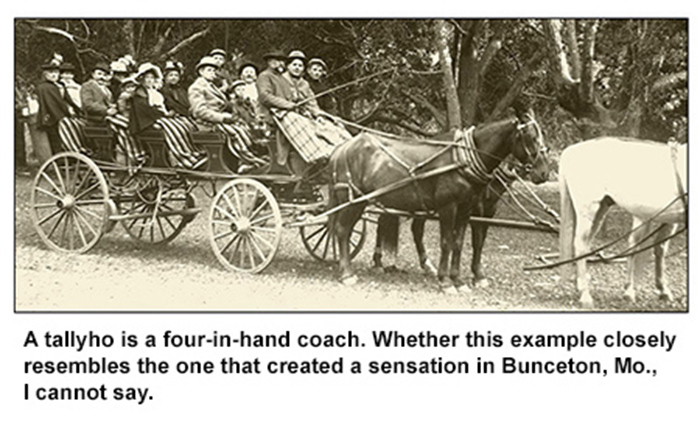New York Evening Telegram, October 24, 1923
By ELISABETH SMITH
One thing is certain.
If Helen Ellwood Stokes ever was in Bunceton, Cooper County, Missouri, she must have felt as out of place as a horseshoe in Henry Ford’s factory.
That was evident on the face of it after yesterday’s session of the Stokes divorce trial in the Supreme Court before Justice Mahoney.
Few days in the history of the long trial have held such contrasts of lightest comedy and tragedy as did that of yesterday.
In the morning there marched in imagination before the spectators all the townsmen of little Bunceton – 900 souls, even to the auctioneer, the telegraph operator, the gentleman who exhibited hogs for prizes.
In the afternoon the atmosphere shifted abruptly. Bunceton and the comedy of its affairs faded from the picture.
In its place a sinister atmosphere filled the courtroom – an atmosphere filled with insinuation and innuendo, concerned with things of which decent folk neither read nor speak nor think.
Digs Deep for Evidence
Surely there have been no depths to which W. E. D. Stokes has not dared to descend to find means for the winning of his case, no slander against the name of his wife and the mother of his children which he has not deigned to employ.
During Bernard H. Sandler’s testimony, Mr. Stokes sat up, briskly alert. He even moved his seat from where he had been sitting somewhat aloof from even his counsel. Previously he had yawned one big yawn after another, and on one occasion, at least, his head had slipped lower and lower while it seemed that he was completely lost to all the world in slumber.
Helen Ellwood Stokes, however, never once changed color nor expression. In all that dark courtroom, down whose windows poured streams of leaden rain, she alone remained the one bright spot. Her expression was as sunny as her golden-red hair, and her smile was ever ready and spontaneous when there was any possible occasion upon which to call it forth.
The morning session was not lacking in such occasions.
Then it was that one knew, without leaving that same Supreme Court with the Municipal Building on one side and the Woolworth Tower on the other, that, after all, both Sinclair Lewis and Edgar Lee Masters were right.
Types Easily Recognized
Spoon River and Gopher Prairie both came straight into Chambers street, and none failed to recognize the types.
After listening to the pages of testimony read in yesterday’s trial, which was taken by a commission appointed by the court, and held in Missouri, all of Bunceton lived for the spectators.
One knew Bunceton as well as one knew Broadway.
One knew that every Sunday there was chicken for dinner after church, and that every Thursday there undoubtedly was a band concert down in Main street.
One knew that there probably wasn’t a soul in all Bunceton who had ever heard of Matisse or Poiret or DeBussy or George Moore, but that there also wasn’t a person who didn’t know exactly what hogs were being quoted at in the Chicago stock market.
By means of the testimony read all the village characters lived for you.
There was Wilbur Wallace, the proprietor of the laundry, brother of Edgar T. Wallace, the corespondent named by Stokes. When writing to Wilbur and A. A. Wallace, another brother, it was established that W. E. D. Stokes addressed the letter in which he reminded them that there were “Masons” and “Methodists” and raised hogs for exhibition purposes.
Then there was Frank Force, who said that he didn’t “do much of anything now.”
There was R. C. Harriman, the cattle rancher and auctioneer.
There was Gid Meeker, the mayor of Bunceton.
There was Roy Brevis, the Western Union Telegraph operator, who said he “delivered the telegrams himself.”
Does Not Fit in Picture
There also was Nelson Leonard. Some way, Nelson Leonard did not fit into the rest of the picture of Bunceton. He lived, his testimony said, on a farm four miles outside of the town, known as the Ravenswood Farm. It was he who owned the tallyho in which one of W. E. D. Stokes’ witnesses previously had testified she had seen Helen Ellwood with Wallace.
A tallyho in Cooper County, Missouri? Yes, hard to believe, isn’t it? Certainly said tallyho was an incongruous note to be introduced in that town.
If you ever become entangled in the lariat of the law, and need the best legal legerdermain of the profession to get you out, here is advice for you:
Get for your lawyers Messrs. Samuel Untermyer and Max D. Steuer. Be sure to get both of them.
That was the trouble of both W. E. D. Stokes and Helen Ellwood Stokes. Neither Mr. nor Mrs. Stokes got both Samuel Untermyer and Max D. Steuer. Each got one of them. And each having one for counsel, the public is being treated to more verbal fireworks than have been seen in the courts in many a day.
Yesterday’s session was no exception. Personalities, shoutings, waving of arms and shaking of fingers in a way reminded one of a play of sharp swords. All were indulged in by the attorneys of both sides. |



